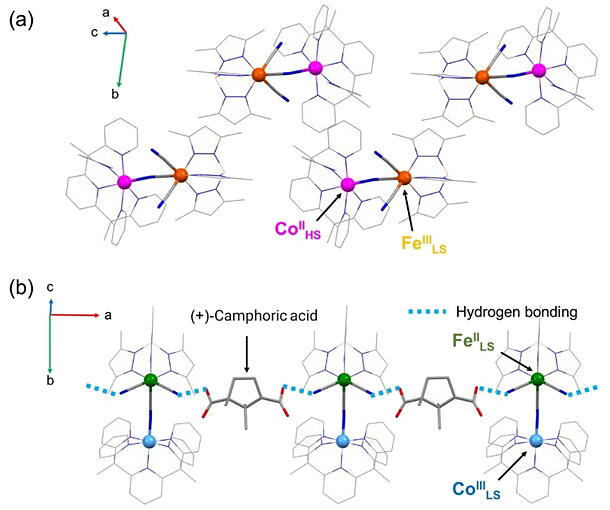A research group comprising Riku Fukushima, first-year doctoral student of the Graduate School of Science and Technology, Associate Professor Yoshihiro Sekine of the Priority Organization for Innovation and Excellence, and Professor Shinya Hayami of the Faculty of Advanced Science and Technology at Kumamoto University succeeded in developing a molecular assembly capable of abrupt and complete magnetic on/off switching through co-crystallizing a metal complex molecular unit that does not respond to an external field with a chiral carboxylic acid to form new hydrogen bonds. The molecular unit comprises a dinuclear structure in which organic molecules bridge cobalt and iron ions. Normally, in a complex molecule composed of different metal ions, electrons cannot move within the molecule.
In this study, a one-dimensional chain assembly developed by assembling molecular units with chiral carboxylic acids exhibited intramolecular electron transfer between cobalt and iron ions with changes in the temperature and magnetic switching behavior, i.e., a reversible transition between the diamagnetic and paramagnetic states. The results of this research reveal that molecules exhibiting the magnetic switching behavior can be developed by applying an assembly method suitable for functional expressions, even when this method is applied to molecular units unresponsive to external stimuli.
Furthermore, the magnetic switching temperature can be controlled by small changes in the constituent organic ligands. Thus, this study presents a new molecular synthesis strategy that enables intramolecular electron transfer via hydrogen bonding. The results were published online in the Journal of the American Chemical Society and selected as supplementary cover art.

(b) Packing structure of compound 3+. Compound 3+ is a hydrogen-bonded one-dimensional assembly, where [CoFe] dinuclear unit was the same as 1.
Provided by Kumamoto University
Journal Information
Publication: Journal of the American Chemical Society
Title: Assembling Smallest Prussian Blue Analogs Using Chiral Hydrogen Bond-Donating Unit toward Complete Phase Transition
DOI: 10.1021/jacs.4c05065
This article has been translated by JST with permission from The Science News Ltd. (https://sci-news.co.jp/). Unauthorized reproduction of the article and photographs is prohibited.




